
Dr Louise Thompson
Senior Lecturer in Politics at the University of Manchester. Her research focuses on the UK Parliament, particularly the legislative process, committees and small political parties. She is convenor of the PSA Parliaments Group.
Email: louise.thompson-4@manchester.ac.uk
Twitter: @louisevthompson

Section 7: News and Journalism
- Time to fix our TV debates
- What was all that about, then? The media agenda in the 2019 General Election
- Pluralism or partisanship? Calibrating punditry on BBC2’s Politics Live
- Hero and villain: the media’s role in identity management
- #GE2019: A tale of two elections?
- Boxing clever: negotiating gender in campaign coverage during the 2019 General Election
- Press distortion of public opinion polling: what can, or should, be done?
- The final verdict: patterns of press partisanship
- The class war election
- An uncertain future for alternative online media?
When the BBC’s Huw Edwards announced the exit poll shortly after 10pm on the 12th December, two figures flashed up on our television screens: the projected number of Commons seats for the Labour Party and the Conservative Party, accompanied by pictures of their respective leaders. The poll predicted a Conservative government, with 368 seats, with the Labour opposition standing at an estimated 191. Such a picture is typical of the UK’s electoral landscape, underpinned by what Dutch scientist Arendt Lijphart termed a ‘majoritarian’ political system; one characterised by (among other things) two main political parties and a first-past-the-post electoral system. For most elections in the post-war period, voters have gone to the polls in the certainty that the either the Conservative or the Labour party would see their leader standing on the steps of Downing Street. For a long time media coverage at election time focused overwhelmingly on the two main parties, with print media nailing their colours to the mast of one of them.
The 2015 General Election (which saw the rise of the SNP at Westminster and the impressive vote share achieved by UKIP) marked the first real step change in this two-party dominance and this was further evidenced in 2019. While the majority of the print media overwhelmingly backed one of the big two parties, The Economist sided with the Liberal Democrats, and some, such as The New Statesman and i News, refusing to endorse any party. The election results themselves also bore this out. While the two main parties received 83% of the vote in 2017, this fell to 73% in 2019. In practice this means that over five million people voted for parties other than Labour and the Conservatives and they returned MPs from eight small parties, bringing the total number of parties represented in the House of Commons to ten.
The weakening grip of the Conservative and Labour parties within an increasingly fragmented party system poses a challenge for broadcasters in their election coverage and reporting. The result in 2019 was something of a cacophony of debates; from a seven way ITV debate, to a four way Question Time special and the BBC’s head-to-head with Boris Johnson and Jeremy Corbyn. Even these did not include all of the political parties standing candidates at the election. Nor did they include all of the political parties who held Commons seats at the time of the election – three sitting Independent Group for Change MPs for example were also standing in their respective constituencies but played no part in any of the debates.
The smaller parties were enthusiastic about their inclusion in these debates, something which Liberal Democrat leader Jo Swinson had pressed for prior to the election, but the two main parties did their upmost to exclude them. When Swinson took legal action against ITV alongside the SNP’s Nicola Sturgeon, Jeremy Corbyn stuck firmly to majoritarian principles, backing the head to head debates between himself and Boris Johnson on the basis that “there are only two possible people who can be prime minister at the end of this campaign”. When smaller parties do gain visibility in election debates they tend to attract support from the public. Nick Clegg outshone everyone for the Liberal Democrats in the 2010 debate and UKIP and the SNP performed particularly strongly in 2015. This time around it was the Brexit Party’s Richard Tice who seemed to impress viewers with his performance.
The haggling over big media appearances is not helped by the ambiguity in Ofcom’s broadcasting code which states that ‘due weight’ and ‘appropriate coverage’ should be given to different organisations and perspectives but does not clarify who these actually are or how such a balance is ensured. Neither is it likely to go away. With analysis showing that a more proportional electoral system would have brought over 70 more seats for the smaller parties, it will be increasingly important to find a balance between majoritarian traditions and multi-party realities of media reporting and programming during election campaigns.
